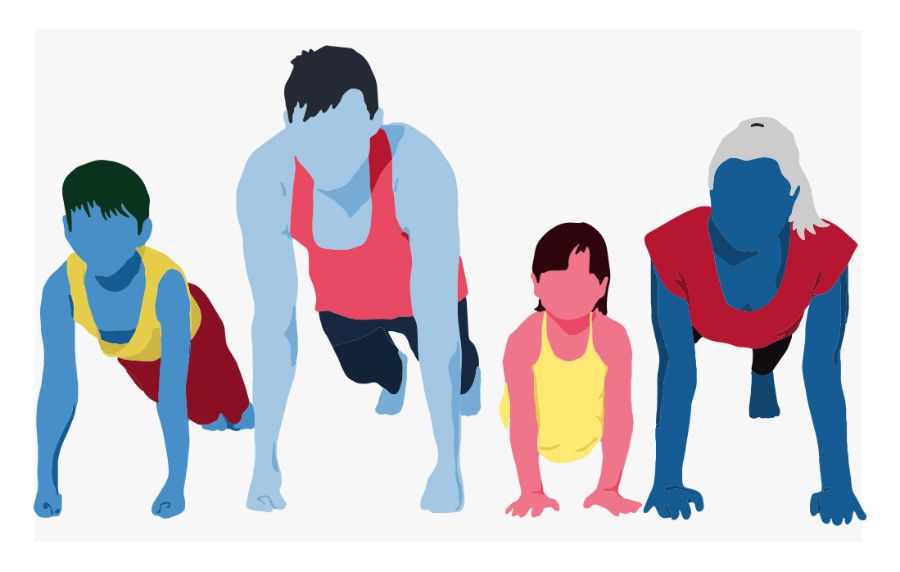The World Health Organization (WHO) defines obesity as excessive body fat accumulation that presents health risks, categorized as a body mass index (BMI) over 30. Obesity rates continue to rise, and as of 2022, 1 in 8 people worldwide were classified as having obesity1, a concerning trend due to obesity’s impact on a number of important health issues.
In the United States, obesity rates are even higher, as 41.9% of adults were obese according to data from 2017 to 20202, and children and adolescents are also experiencing an increase in excess body weight. This isn’t meant to shame or judge anyone with bodyweight challenges, but as obesity is associated with a number of serious health risks, it’s worth taking a closer look.
In this article, I’ll share the most recent obesity statistics, and share my best tips for sustainably maintaining a healthy weight, based on 12 years of experience as a personal trainer and certified nutrition coach.
Please note, our intention is not to reduce people to their bodyweight, and we understand that obesity is defined by BMI, which has been shown to be an outdated health metric7. When we use the term obese, we’re referring to the clinical term used by medical practitioners.

Medical disclaimer: This article is intended for educational and informational purposes only. It is not intended as a substitute for medical advice. For health advice, contact a licensed healthcare provider.
Key Takeaways
- In 2022, 1 in 8 people worldwide had obesity1.
- According to the NIDDK3, nearly 1 in 3 adults in the U.S. have obesity, with over 2 in 5 being severely obese.
- 41.9% of adults in the U.S. have obesity2.
- Obesity in children and adolescents (ages 2-19) was reported at 19.7%4 from the years 2017-2020.
- For adults, a BMI of 30+ is considered obese; in children and teens, obesity is a BMI in the 95th percentile or greater.
Obesity in America
While obesity rates continue to rise worldwide, this article is specifically focused on obesity in America, where rates are trending upward year after year. The problem has become so serious that the WHO describes this as an obesity epidemic, as it’s a serious health risk to the American population.

RELATED: Fitness Statistics for 2024
Overweight and obese status is determined by BMI, calculated using height and weight. Overweight is classified as having a BMI over 25, and obese is classified as having a BMI over 30. A healthy weight is considered as having a BMI between 18.5 and 24.9.
BMI isn’t a perfect measure, as it doesn’t account for body composition. This means that having a higher-than-average amount of muscle mass will add scale weight and increase your BMI.
Whether or not your BMI is a health concern is a discussion you should have with your healthcare provider, but for the majority of people, having obesity and a high BMI is not something to take lightly.
RELATED: Cardio vs. Weights for Weight Loss
According to the National Institute of Diabetes and Digestive and Kidney Diseases (NIDDK), being overweight or obese is associated with a long list of chronic diseases and health concerns5. I won’t list them all here, but some of the most serious obesity-related health outcomes include:
- Type 2 diabetes
- High blood pressure
- Cardiovascular disease
- Increased risk of developing certain types of cancer
- Fatty liver disease
- Mental health problems
Obesity in American Adults
Now that I’ve established what obesity is, let’s take a closer look at the current statistics about overweight and obesity in adults over the age of 20.
According to an NIDDK study3 that examined data from 2017 to 2018, 30.7% of adults have a BMI greater than 25 and are classified as overweight. This includes 34.1% of adult men and 27.5% of adult women.

That same study found that 42.4% of adults have crossed the BMI threshold of 30 and now have obesity, including 43% of adult men and 41.9% of adult women. 9.2% of adults have severe obesity, which means they have a BMI over 40.
If you’re interested in checking your own BMI, you can use this BMI calculator from the NIH.
For reference, here’s the classification chart:
- BMI of 18.5 to 24.9: Normal weight
- BMI of 25 to 29.9: Overweight
- BMI over 30: Obese
- BMI over 40: Severely obese
Obesity in American Children
Unfortunately, adults aren’t the only group impacted by this epidemic, as childhood obesity rates are also increasing. The same study3 that measured obesity rates in adults over the age of 20 also looked at childhood and adolescent obesity and found that rates are increasing in nearly all age groups.
According to data from 2017 to 2018, the study found that in children ages two to five, 13.4% had obesity. In children ages six to 11, 20.3% had obesity, and in children ages 12 to 19, 21.2% had obesity.

When you look at the combined data from childhood to adulthood, you can see that excess weight gain tends to start at an early age and increase with age.
If you’re a parent who’s curious about your child’s BMI, the Centers for Disease Control and Prevention (CDC) has put together a helpful calculator. Rather than using set BMI guidelines to determine body weight status, the CDC uses percentiles6, which you can see below.
- Underweight: Less than the 5th percentile
- Healthy weight: 5th percentile to less than the 85th percentile
- Overweight: 85th to less than the 95th percentile
- Obese: 95th percentile or greater
- Severely obese: 120% of the 95th percentile
Global Obesity
While U.S. adults may be among the world leaders in rates of obesity, we’re not the only country experiencing a rise in adult obesity.
The WHO1 found that in 2022, 890 million adults around the world were obese. If this seems like a large number, it is, and worldwide obesity has doubled since 1990 in adults and quadrupled for adolescents.

It’s hard to pinpoint any specific risk factors for developing obesity. There are multiple factors at play, including the rise of processed foods, jobs that keep us sedentary throughout the day, income inequalities that make healthy food inaccessible, and many more. Regardless of the cause, this is a public health concern that shouldn’t be ignored.
Weight Loss Tips
The climbing rates of obesity may seem alarming, and our modern lifestyles certainly don’t make maintaining a healthy weight easy or convenient. If anything, the easy access to all sorts of high-calorie, processed foods, combined with sedentary lifestyles and an emphasis on convenience, makes losing weight very difficult.
RELATED: Best Weight Loss App
Thankfully, I’m not going to leave you hanging. Losing weight (and keeping it off) isn’t easy; however, with the right habits, you can certainly take action to improve your health and strive to maintain a healthy body weight, reducing the risk of developing various health problems as you age.
There are a few methods I’ve recommended to many clients over the years that can help you get started without requiring any drastic actions, so I’m going to share my best weight loss tips below.
Of course, you should consult a medical professional before making changes to your fitness and nutrition routine, as they may recommend specific medical interventions.

Weight loss only occurs in a calorie deficit, which is when you’re eating fewer calories than you burn each day. Don’t fall for flashy or weird diets or dramatic claims from “experts” selling you something; weight loss comes down to energy balance.
There are many ways to go about this, and the best weight loss programs can help you dial in your routine, but here are some quick tips you can start using as soon as today.
- Increase your physical activity. While your body is constantly burning energy, even at rest, regular movement is a fantastic way to boost your health and burn more calories. You can lift weights, go for a run, ride a bike, or even go for a walk on your lunch break. It doesn’t have to be anything fancy; just find ways to include more movement each day.
- Consume high-protein foods with each meal. Of the three macronutrients—protein, carbohydrates, and fats—protein is the most filling and can help manage your appetite. Protein also has a high thermic effect of food (TEF), which means you’ll burn extra calories simply from the work required to digest and absorb it.
- Add more fruits and vegetables to your diet. Fruits and veggies are packed with vitamins, minerals, and antioxidants, and many are also rich in fiber, another key nutrient that can help improve your digestive health and keep you full between meals.
- Consider tracking your macronutrients. If healthy eating isn’t helping you lose weight, you may want to track your macros for a while. This is like budgeting, as it shows you your true food intake, and you can adjust your diet if you’re overeating or undereating any of the macros or reduce your overall food intake if needed.
- Hire an expert for professional help. Finally, for professional help and guidance, it’s never a bad idea to consult with a registered dietitian, a certified nutrition coach, or even work with an online personal trainer to help boost your fitness routine.
RELATED: Macros for Weight Loss
Obesity Statistics: Final Thoughts
The global rise in obesity is a serious health concern that we should all be aware of. The intention of this article isn’t to judge or shame anyone with obesity, but simply to bring awareness, as an unhealthy body weight is associated with many serious health concerns, like an increased risk of heart disease, diabetes, and hypertension.
If you’re focused on your own weight loss journey, the tips I’ve shared above may help you get started. Focus on daily movement, regularly consuming healthy foods, and of course, speak to your doctor if you have any concerns about your body weight and any health risks.
Obesity Statistics: FAQs
What are the current statistics of obesity?
According to data from 20183, 42.4% of adults a BMI greater than 30, which is clinically defined as having obesity. This includes 43% of adult men and 41.9% of adult women. In addition, 9.2% of adults have severe obesity, which means they have a BMI over 40.
What percentage of Americans over 20 are obese?
The most recent data3 shows that as of 2018, 42.4% of Americans over the age of 20 have a BMI greater than 30, which is clinically defined as having obesity.
What race is most likely to be obese?
According to the Food Reserach & Action Center (FRAC)9, “substantial disparities also exist based on race-ethnicity,” based on data from the 2015-2016 National Health and Nutrition Examination Survey. The survey classified adults based on their ethnicity, using the terms White, Black, Asian, and Hispanic. In women, obesity rates were the highest in Black women (54.8%), followed by Hispanic women (50.6%), White women (38%), and Asian women (14.8%).
In adult men, obesity rates were the highest in Hispanic men (43.1%), followed by White men (37.9%), Black men (36.9%), and Asian men (10.1%).
References
- World Health Organization: WHO. (2024, March 1). Obesity and overweight. https://www.who.int/news-room/fact-sheets/detail/obesity-and-overweight
- FastStats. (n.d.). Overweight Prevalence. https://www.cdc.gov/nchs/fastats/obesity-overweight.htm
- Overweight & Obesity Statistics. (2024, June 27). National Institute of Diabetes and Digestive and Kidney Diseases. https://www.niddk.nih.gov/health-information/health-statistics/overweight-obesity
- Stierman, B., M. D. ,. M. P. H., Afful, J., M. S., Carroll, M. D., M. S. P. H., Chen, T.-C., Ph. D., Davy, O., M. P. H., Fink, S., M. A., Fryar, C. D., M. S. P. H., Gu, Q., Ph. D., Hales, C. M., M. D. ,. M. P. H., Hughes, J. P., M. P. H., Ostchega, Y., Ph. D. ,. R. N., Storandt, R. J., M. T. (A. S. C. P. ), M. S. P. H., & Akinbami, L. J., M. D. (2021). National Health Statistics reports. National Health Statistics Reports, Number 158. https://www.cdc.gov/nchs/data/nhsr/nhsr158-508.pdf
- Health Risks of Overweight & Obesity. (2024, June 24). National Institute of Diabetes and Digestive and Kidney Diseases. https://www.niddk.nih.gov/health-information/weight-management/adult-overweight-obesity/health-risks
- Child and Teen BMI categories. (2024, June 28). BMI. https://www.cdc.gov/bmi/child-teen-calculator/bmi-categories.html
- American Medical Association. (2023, June 14). AMA adopts new policy clarifying role of BMI as a measure in medicine. https://www.ama-assn.org/press-center/press-releases/ama-adopts-new-policy-clarifying-role-bmi-measure-medicine
- Wang, L., Southerland, J., Wang, K., Bailey, B. A., Alamian, A., Stevens, M. A., & Wang, Y. (2017). Ethnic Differences in Risk Factors for Obesity among Adults in California, the United States. Journal of obesity, 2017, 2427483. https://doi.org/10.1155/2017/2427483
- Obesity in the U.S. – Food Research & Action Center. (2019, October 3). Food Research & Action Center. https://frac.org/obesity-health/obesity-u-s-2#:~:text=Adult%20Obesity%20in%20the%20U.S.,Black%20men%20(36.9%20percent).







